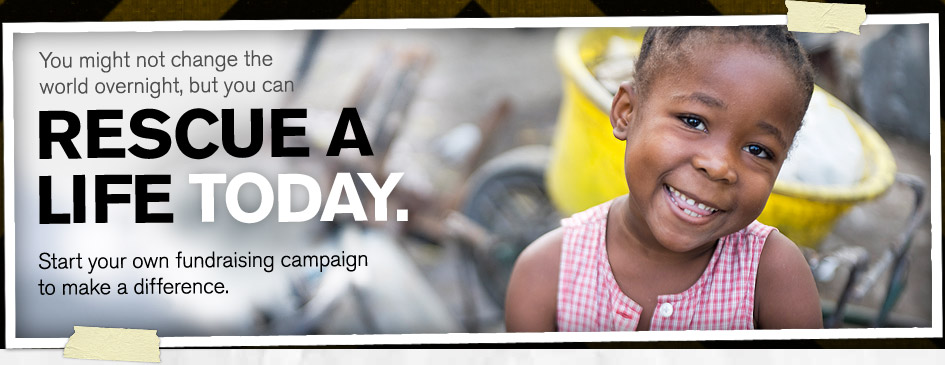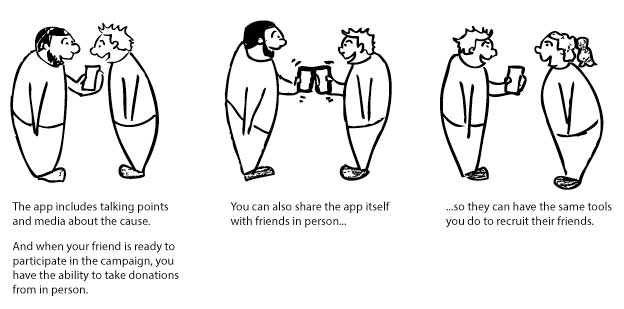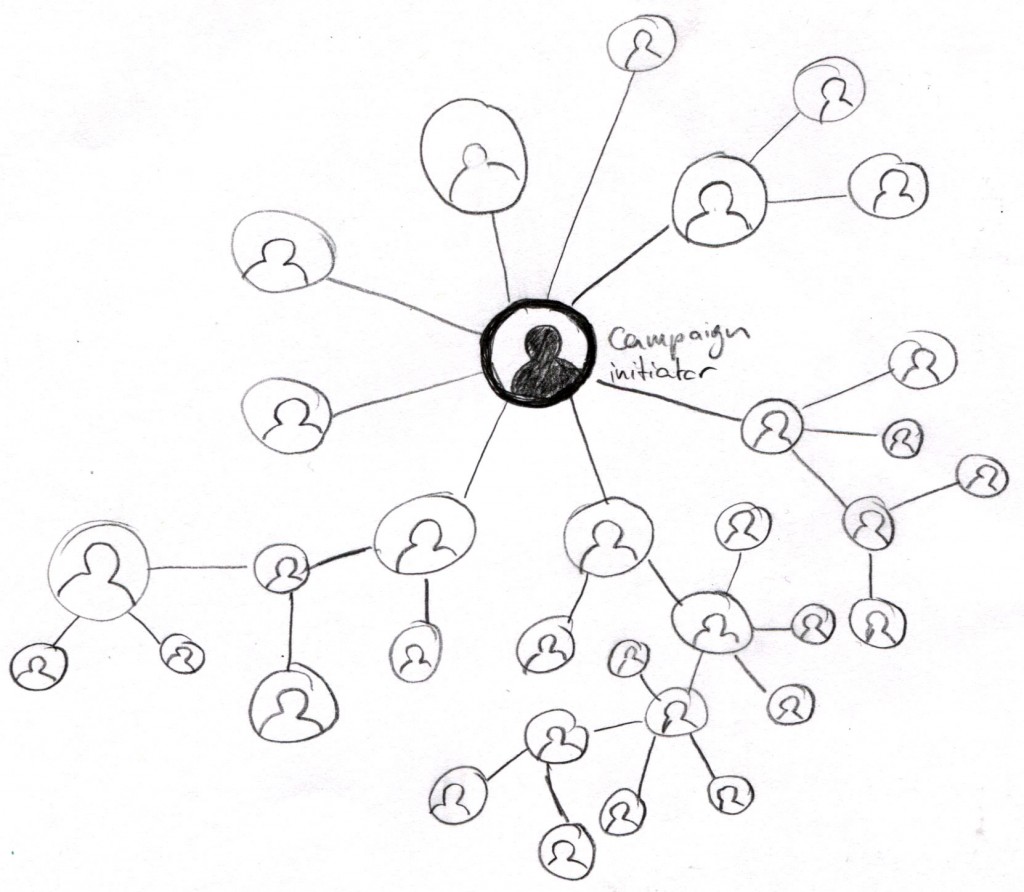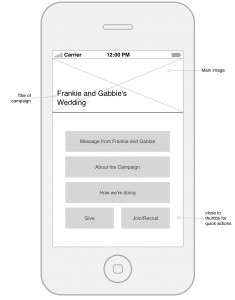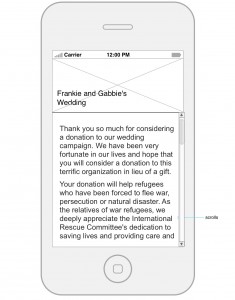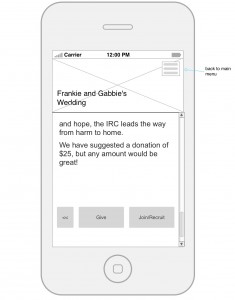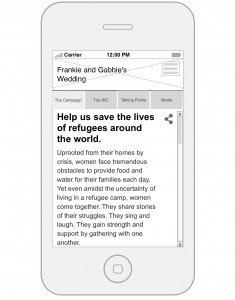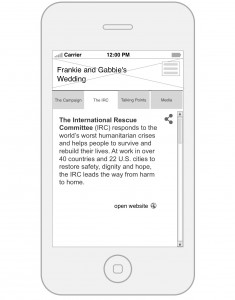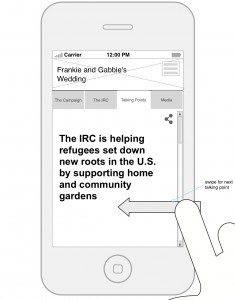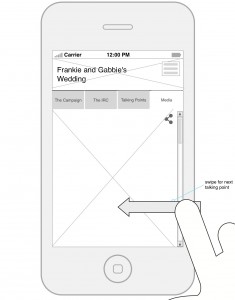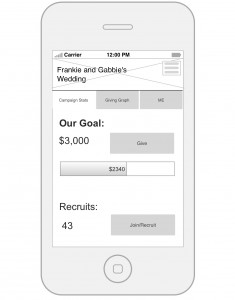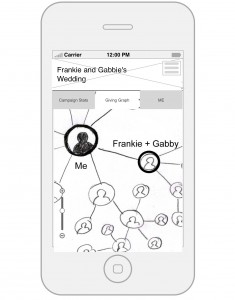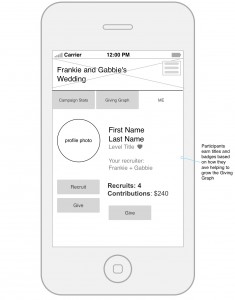The Brief
Based on a creative brief, my classmate Carlin and I have been thinking about how a the International Rescue Committee could use mobile-based technologies as a way to ultimately garner donations and raise awareness about the organization.
Looking at some of their competitors, we didn’t find much on mobile. My research on uses of mobile tech in non-profit organizations didn’t garner much beyond stressing the importance of creating a mobile-friendly version of their website. I think that that is a given.
For this exercise, we wanted to see if we could do more.
iRescue Campaign
We decided to focus on the existing IRC campaign called iRescue, a DIY fundraising campaign. You sign up, choose a cause, customize a webpage, send the links to friends, and try to get them to help you reach your goal and donate money to the IRC on your behalf. Some popular iRescue campaigns right now are Tattooers for Japan, Mary & Tom’s Wedding, and The National Social Work Campaign.
Working with this group of users there are a few advantages:
- they are already supporters of IRC and understand the need for funds
- they are planning to engage their network of friends to be supporters themselves
- Research suggests that 70% of fundraising is done through family and friends
If we can help iRescue group with their own goals, in the end it’s benefitting both the participants and the organization, while engaging a network of people who otherwise wouldn’t be a part of the IRC family. This how we decided to construct our app.
Our Goals
We already have IRC supporters who are engaging their friends in their cause by raising awareness and collecting donations. How can we propagate this action to the second tier of engaged givers so that they too would want to avocate for the cause and engage their own network to then then donate? How can we create a ripple, effectively engaging subsequent layers of networks, collecting donations, raising awareness, and spreading the cause?
We also wanted to take advantage of the fact that this app will be used from a mobile phone. Carlin and I talked about the fact that we carry our cells with us everywhere. And I am particularly interested in how we can use this ubiquitous tool to connect with one another in person.
The Idea
The iRescue app is a way to help grow a network of donors for your campaign. It enables you to take in donations in person as you talk to your friends about the issues you are supporting and why you want to help the IRC. In exchange for the donation, your friend gets a copy of the app from you and is then encouraged to get other donors on your behalf. The network grows are more people are engaged.
Everyone with the app gets updates about the campaigns and can watch how it grow closer and closer to its goal through the efforts of individuals. Individual donors are linked to their parent donors (their recruiter) and to the people who they spread the app to in turn.
Using Game Mechanics
For this app to be successful, for the network of givers to really grow, we need to make sure that there is an incentive for users to share the app and the story with others. The Campaign Initiator is the main source of inspiration. He or she has started the campaign because they believe in what the IRC does or they wish to support a cause that the IRC is backing. This has motivated them enough to recruit friends to try to do the same.
As we move further away from the Campaign Initiator in Giving Graph (above) those givers are further away from the original source of motivation. To boost motivation at these tiers of engagement, we look to game mechanics.
Titles and Badges
Carlin and I discussed how we might assign badges or some sort of social status to givers depending on how their network is growing, in a similar manner to foursquare, in gaming chat forums, and even Kickstarter campaigns. In some gaming chat forums, you would earn a title rank based on how much you participate in the chatroom or in the game itself. Givers in the campaign would earn titles base on how many people they’ve recruited and how those people recruited others. There can also be titles for being active on social networks (online promotions) or how fast or how slow they recruit people.
The idea is to recognize those that are pushing mission, growing the graph, and ultimately helping the campaign reach it’s goal.
The “Game” Board – Visual Graphs
The visuals of the Giving Graph will also show the progression of network and identify active and inactive participants. Our hope is that people will either be motivated to see their section grow and their titles change or be motivated by seeing how other people are pushing the mission.
Alerts
The app will also alert players of the status of the campaign as it progress.
Main Takeaways
- about engaging the second tier of givers, and subsequent givers, getting them excited about the campaign and participating
- the app supports already existing in-person relationships, it’s not about the app itself, it’s about the network
- using game mechanics and infographics to recognize those that are pushing the mission and keeping that engagement up
- empowering givers with a tool that they can then share with people they care about
- pings and notifications keep givers informed of the state of things
- using real data, metrics, and media to tie donations to action items from the IRC
